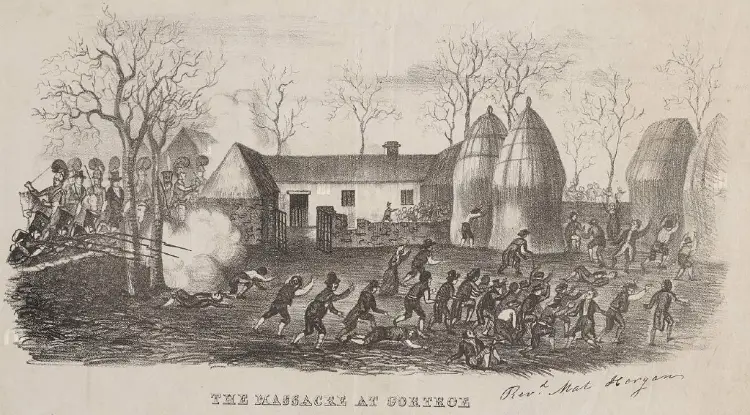The TIthe Applotment Books are a valuable resource to identify where in Ireland your ancestors lived in the decades prior to the Great Famine.
These books are one of the most important Irish census substitutes for the 19th century. However, like other records which stand in for the lost 19th century censuses, they were not designed to be used as such. They are, first and foremost, a record of various land tenancies compiled for the purpose of levying a tax for the upkeep of the Church of Ireland.
So, while the Tithe Applotment Books contain information on the majority of households in Ireland, they are far from a complete list. They do not include people who lived in urban areas. They omit landless rural dwellers and those who occupied less than an acre of land.
The books also only name the head of each listed household.
What are the Tithe Applotment Books?
Tithes were, historically, a payment made for the upkeep of the church. Farmers traditionally paid a tenth – or tithe – of their produce to the church in a system that pre-dates Christianity.
Under the Reformation in the 16th century, Henry VIII established the Anglican Church of Ireland and obliged farmers – the majority of whom were Catholic – to pay tithes to the Established Church. By the early 19th century, tithes were sometimes paid in cash, sometimes in produce, and sometimes not at all.
The Tithes Composition Act 1823 sought to regularise the tithes system. In effect, the Act enforced cash tithes on all landholders of an acre or more.
In order to administer the new cash system for tithes, a national survey was carried out to value tithable land. This survey was organised by civil parish and by townland, listing the occupier of each qualifying holding, the area and value of the land, rent paid, and tithes due on the holding.
All of this information was gathered in a series of books – the Tithe Applotment Books – between 1823 and 1838.
How to use the Tithe Applotment Books
The Tithe Applotment Books are available to browse or search, free of charge, on the National Archives website.
A word of warning – the Tithe books were transcribed ‘as is’ and contain numerous errors. This can make searching the books difficult.
As an example, my 3x great grandfather John Culleton lived in the townland of St Iberius, Lady’s Island parish, Co Wexford, in the 1830s. I know where his house was, so I should be able to locate him easily. And I can, but not by searching his name. John’s surname was misspelled in the original Tithe book, and misspelled again during transcription, so he is recorded on the National Archives website as John Cuttelhan.
The Tithe Applotment Books were originally microfilmed by the Church of Jesus Christ of Latter Day Saints and are also available, and searchable, on FamilySearch.org. However because of the misspelling, my John Culleton is not among the results returned if I search for him by name.
Similarly, my 3x great grandfather William Sinnott, who lived in the neighbouring townland of Eardownes Great, does not turn up if I search for him by name, principally because he is listed as Wm Sinnott of Eardownes in the Tithe book.
Ancestry also provides a searchable index of the Tithe Applotment Books, but does not have images of the books themselves.
Townland and parish names can also be misstated or misspelled in the indexes. For example, my William Sinnott is listed in Eardownes, St Mary’s parish, on Ancestry. Eardownes Great is in the civil parish of Lady’s Island; it is listed under Lady’s Island in the National Archives index, though it is spelled as one word – Ladysisland.
For all these reasons I recommend finding people by browsing the records by parish and townland on the National Archives site rather than relying on a text search. This is when knowing where your ancestors lived in terms of various land divisions really becomes useful.
Browsing the books on the National Archives website reveals that 30 counties are listed in total – in fact, there are 29 counties as Laois and Queen’s County are both listed separately (all Laois parishes except Ballinakill are listed under Queen’s County).
The website has all the available Tithe books for the 26 counties that comprise the Republic of Ireland, but just a selection of books for parishes in Armagh, Down, and Fermanagh in Northern Ireland. The full collection of Tithe books for the six counties of Northern Ireland is available on the Public Records Office of Northern Ireland website – you will need to enter ‘Tithe Applotment Book’ in the top search field.
What you will find
The information contained in the Tithe Applotment Books is fairly basic. The books are not standardised and vary from parish to parish. In general, they record the name of the tenant, the quality and area – in acres, roods and perches – of land they rented, rent paid on the land, and the tithes payable.
While there is no information on the family or their house, the details of the land they occupied give some insight into how your ancestors lived. The acreage and quality of land they had was a good indicator of how affluent – or poor – they were.
In the absence of 19th century census records – and particularly in areas where no parish records are available for the 1820s and 1830s – this may be the only record you will find of your ancestors in this period.
The Tithe War
Catholics opposed the payment of tithes to the Church of Ireland from their introduction. Catholic farmers were, effectively, legally bound to pay for the upkeep of Protestant churches, which they didn’t use, and morally bound to pay for the upkeep of Catholic churches, which they did use.
The Tithe War of the 1830s saw Catholic farmers oppose the tithes, largely through civil disobedience – non-payment of tithes. There were also several outbreaks of violence, both against farmers resisting the payment of tithes, and on tithe collectors who tried to enforce payment by seizing livestock.
Significant violent clashes during the Tithe War included the massacres of civilians by police and yeomen at Newtownbarry in Co Wexford (1831) and Rathcormac in Co Cork (1834), and the killing of a process server and 12 policemen in an ambush at Carrickshock, Co Kilkenny (1831).
The war ended with the Tithe Act 1838, which transferred the responsibility for tithes from tenant farmers to landowners, who were almost exclusively Anglican. The ultimate effect of this was that tenant farmers paid the landlords’ tithes indirectly in the form of higher rents.
Main image: The Massacre at Gortroe by Rev Matthew Morgan (1848), a lithographic print depicting the massacre of at least 12 civilians by policemen and soldiers at Gortroe, near Rathcormac, Co Cork, on 18 December 1834 during the Tithe War. Courtesy of the National Library of Ireland via Wikimedia Commons.

Una Sinnott
I love exploring how our ancestors lived, and what we can find out about them from the records they left behind. Get in touch if you need help researching your Irish roots.

